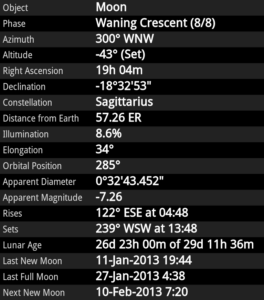This view displays orbital data for the selected object calculated for the given time and location.

The fields shown vary slightly between the Sun, Moon and Planets, from the following list:
Azimuth: the bearing that the object is at as viewed from the current location. Angles measured clockwise from true north.
Altitude: the height in the sky of the object above the horizon.
Right Ascension/Declination: the celestial Longitude and Latitude of the object projected in the equatorial coordinate system.
Constellation: An approximation of the constellation in the sky that the object can be found in. An arrow before or after the name signifies that the object is current moving into or out of the constellation.
Distance from Earth: current distance of the object from the Earth, measured in Astronomical Units (for the Sun and other Planets), or Earth Radii (for the Moon)
Distance from Sun: current distance of the object from the Sun, measured in Astronomical Units.
Ilumination: the percentage of the objects surface facing Earth that is lit by the Sun. (For the Moon and Inner Planets this can vary from 0-100%, but for the Outer Planets is usually >90%)
Elongation: the angle subtended between the object and the Sun, viewed from the Earth. A small elongation indicates that the object appears close to the Sun (as viewed in the our sky), whereas an elongation closer to 180° indicated that the object is on the opposite side of the Earth from the Sun.
Orbital Position: the angle of the object in its orbit around the Sun (or Earth, for the Moon), measured anti-clockwise from the autumnal equinox.
Apparent Diameter: the angular diameter of the object in the sky, based on its physical size and distance from the Earth. (eg the Moon and Sun have similar Apparent Diameters, since the Sun is about 400x bigger than the moon but is also about 400x further away)
Apparent Magnitude: a measure of how bright the object appears in the sky, based on its size, distance from Earth, distance from the Sun, phase and surface reflectivity. Values are given on a reversed scale, so brighter objects have a smaller (or negative number). Typical values eg: The Sun -26, Full Moon -12, Venus -4, Neptune +8
Rise: Time and Azimuth that the object rises at the current location.
Transit: Time that the object achieves its maximum altitude at the current location (roughly halfway between Rise and Set)
Set: Time and Azimuth that the object sets at the current location.
Day Length [Sun Only]: The total hours of daylight at the current location.
Phase: shows the current phase of the Moon, in text and eighths. eg Waxing Gibbous, Waning Crescent, Full Moon, etc
Lunar Age: gives the time (in Days:Hours:Mins) since the previous full moon, and also the total duration of the current lunar cycle (which varies slightly each month due to the Moons elliptical orbit)
Last/Next New Moon: gives the Date/Time of the previous and next New Moon.
Last/Next Full Moon: gives the Date/Time of the closest Full Moon in the current cycle (which may be ahead or behind in time).
